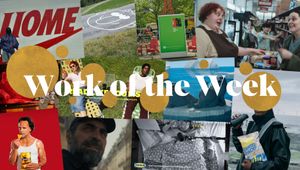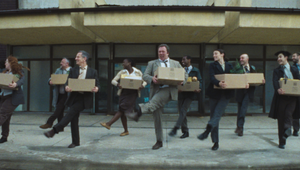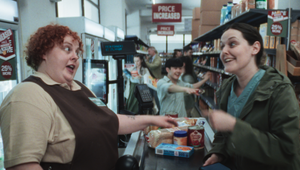
Insight into IKEA’s 'Playin' With My Friends'

When Ikea released their joyful new TV campaign, a music video called ‘Playin’ with My Friends’, we were pretty excited. Its jolly, it’s pop, it’s directed by Dougal Wilson and it’s got a giant dancing toy dinosaur… we didn’t think that we could possibly love it any more. Then on Tuesday Mother London proved us wrong. They released a novel making-of film that detailed the experiences of the star of the show, a gruff, grizzly Glaswegian called Darren The Bear. We caught up with creatives Thom Whitaker and Danielle Noel to find out more.
LBB> What was the original brief from Ikea?
DN> They’ve got all these different products that help make socialising in the home easier, especially when you’ve got children, and they’ve got a belief that adults and children behave better when they’re sitting round the same table. They wanted to communicate that through the ad because they believe that everyone should sit together and be treated quite equally, and that everyone has more fun that way.
LBB> The idea of creating a music video-esque spot is something we’ve seen from Ikea before – for example the Kim Gehrig’s Kitchen Party ad and the David Wilson-directed Bright Shiny Colours ad. What did the music video approach bring to this particular campaign?
TW> We decided we should continue that with our new campaign, so every spot is going to be a sort of music video, with these shorter 60 or 30 second versions that will run as TV ads. Obviously Dougal Wilson was the perfect choice for the new campaign because he has such a good reputation in both music videos and commercials so we knew we were in really good hands.
DN> This piece itself was created to launch Ikea’s new strategy, which is to focus on different activities that you can do in the home rather than creating campaigns room-by-room. This was the first ‘entertaining’ one, and it was about children, so it really made sense to make a music video that was fun and imagined through the eyes of a child.
LBB> When you were developing the idea, what sort of inspiration did you use to come up with the different characters? Did you spend much time revisiting your own childhoods?
DN> We definitely drew inspiration from our own childhood favourites. It was a great opportunity to do something that appealed to both kids and adults, so it had that nostalgic sense to it, that everyone could relate to.
TW> It was really fun thinking about all the different types of toys and thinking about what people would relate to with their own childhood.
DN> It was a pretty hectic shoot on the set though, with all these massive toys and children. You can only imagine!
LBB> It’s quite a choreographed piece, how did you pull that off considering there were so many young children involved?
DN> It was tricky; there were a lot of rehearsals beforehand actually. We went out a few days before the shoot going over and over with the children to make sure everything was in time because we wanted it to feel like one shot. Although there were a couple of cuts in there, we wanted it to feel like it was all done in one shot, which was a bit of challenge because it was such a big set, there were so many children and people in these massive suits.
LBB> And I imagine the kids on set must have been pretty excited to be working with giant teddy bears and robots…
DN> The kids absolutely loved them, it was very sweet actually. It was a very fun set; everyone seemed to be enjoying it.
LBB> Where was the shoot?
TW> It was shot in Romania, in Bucharest, because we needed to build a set that looked like a house but was also big enough to accommodate six giant soft toys, so that was our best option for studio space.
LBB> In terms of the art direction and the colour palette, what feeling were you trying create?
TW> Fortunately we had all of the Ikea props and products that we could use so we could design the set however we wanted to. I think Dougal always had it in his mind that he wanted to create a world like a kids’ TV show, while keeping it quite realistic at the same time. So there were lots of block colours, it was vibrant and designed to be quite eye-catching on TV and the sort of thing that kids would enjoy watching just as much as grownups.
DN> At the same time we wanted to stay quite realistic and create the sort of household that you could imagine a child living in. Striking that middle ground was important to us. And also making sure it was fun as it was seen through the eyes of a child.
LBB> Which toys from the ads were your favourites?
TW> I think the Robot’s got to be my favourite – I love the way he walks.
DN> It’s got to be the dinosaur!
LBB> While you were working on the main TV campaign, there was a team putting together the rather entertaining ‘making of’ film. How involved were you in that?
DN> A lot of that was handed over to BOSH who works within the agency. We had a camera man who was out filming the toys when we weren’t filming but because of the hectic filming schedule we knew a lot of it would have to be done back here in England.
TW> They managed to get hold of the bear costume and went away for a day or two to an Ikea store, and they put it together with the footage from Romania. It was brilliant.
LBB> What does that extra piece of content bring to the world that you’ve created for the TV campaign?
TW> I think the two go hand-in-hand really nicely. The making-of strikes that perfect balance of giving you an idea of what it was like on set and how the set looked and who does what but then also giving you a slightly different point of view. It was nice to give the bear actor a back story.
LBB> What were the most challenging aspects of the project?
DN> I think the whole project was a challenge in itself. There was a lot to get right: the timing, trying make it look like a one-shot, working with the massive costumes. There were a lot of chances taken and Dougal pulled it off fantastically and it all came together in quite a short space of time.
Credits
TV
Creative Agency: Mother
Art Director: Mother
Copywriter: Mother
Planner: Mother
Agency Producer: Mother
Director: Dougal Wilson
Production Co: Blink
Producer: Ewen Brown
Editor: Ed Cheesman
Editing House: Final Cut
Post Production: MPC
VFX: MPC
VFX Producer: Julie Evans
VFX Supervisor: Tom Harding
Grade: Jean-Clement Soret
Audio post-production: 750mph
Sound Design: Sam Ashwell
DoP: Stephen Keith Roach
Music: ‘Playin With my Friends’ by Robert Cray
Print
Creative Agency: Mother
Art Director: Mother
Copywriter: Mother
Planner: Mother
Agency Producer: Mother
Photographe: Nick Ballon
Typographer: Mother
Making-of
Creative Agency: Mother
Art Director: Mother
Copywriter: Mother
Planner: Mother
Agency Producer: Mother
Director: BOSH
Production Co: BOSH















